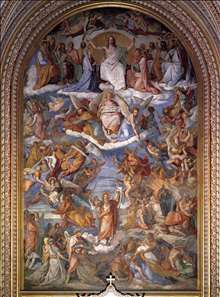German painter, best known for the major part he played in the revival of fresco in the 19th century. After training at the Dsseldorf Academy Cornelius moved to Italy in 1811 and joined the Nazarenes in Rome. In 1819 he was called to Munich by Crown Prince Ludwig of Bavaria (later Ludwig I), for whom he worked extensively, notably on a series of frescos in the Ludwigskirche (1836-39), including a
Last Judgement that is larger than Michelangelo s in the Sistine Chapel. When this work was not well received Cornelius left Munich to work for Frederick William IV of Prussia in Berlin. His major undertaking there was a commission for frescos in a mausoleum for the royal family. The project was officially cancelled after the revolution in 1848, but Cornelius continued to work on his
drawings for it for the rest of his life.
Cornelius s work is undoubtedly impressive, but rather self-conscious in its desire to revive the heroic pictorial language of
Raphael and
Michelangelo, and combine it with the didactic philosophy of German Romanticism. He was director of the academies at Dsseldorf and Munich and his influence was considerable; it may well be claimed that his works in Munich sparked off the revival of large-scale fresco decoration in Germany and perhaps elsewhere. His advice was sought when frescos were painted in the Houses of Parliament, London in the 1840s.
If you want write a review , you have to be registered.




